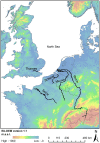Mesolithic projectile variability along the southern North Sea basin (NW Europe): Hunter-gatherer responses to repeated climate change at the beginning of the Holocene
- PMID: 31314774
- PMCID: PMC6636730
- DOI: 10.1371/journal.pone.0219094
Mesolithic projectile variability along the southern North Sea basin (NW Europe): Hunter-gatherer responses to repeated climate change at the beginning of the Holocene
Abstract
This paper investigates how former hunter-gatherers living along the southern North Sea coast in NW Europe adapted to long-term and short-term climatic and environmental changes at the beginning of the Holocene. It is argued that contemporaneous hunter-gatherers repeatedly changed their hunting equipment in response to changing climate and environment, not just for functional reasons but mainly driven by socio-territorial considerations. Based on a Bayesian analysis of 122 critically selected radiocarbon dates a broad chronological correlation is demonstrated between rapid changes in the design and technology of stone projectiles and short but abrupt cooling events, occurring at 10.3, 9.3 and 8.2 ka cal BP. Combined with the rapid sea level rises and increased wildfires these climatic events probably impacted the lifeways of hunter-gatherers in such a way that they increasingly faced resource stress and competition, forcing them to invest in the symbolic defense of their social territories.
Conflict of interest statement
The author has declared that no competing interests exist.
Figures





References
-
- Smith DE, Harrison S, Firth CR, Jordan JT. The early Holocene sea level rise. Quaternary Science Reviews 2011; 30: 1846–1860.
-
- Theuerkauf M, Bos JAA, Jahns S, Janke W, Kuparinen A, Stebich M, et al. Corylus expansion and persistent openness in the early Holocene vegetation of northern central Europe. Quaternary Science Reviews 2014; 90: 183–198.
-
- Magny M, Bégeot C, Guiot J, Peyron O. Contrasting patterns of hydrological changes in Europe in response to Holocene climate cooling phases. Quaternary Science Reviews 2003; 22: 1589–1596.
-
- Wanner H, Solomina O, Grosjean M, Ritz SP, Jetel M. Structure and origin of Holocene cold events. Quaternary Science Reviews 2011; 30: 3109–312.
-
- Marlon JR, Bartlein PJ, Daniau A-L, Harrison SP, Maezumi SY, Power MJ, et al. Global biomass burning: a synthesis and review of Holocene paleofire records and their controls. Quaternary Science Reviews 2013; 65: 5–25.
Publication types
MeSH terms
LinkOut - more resources
Full Text Sources
Medical

